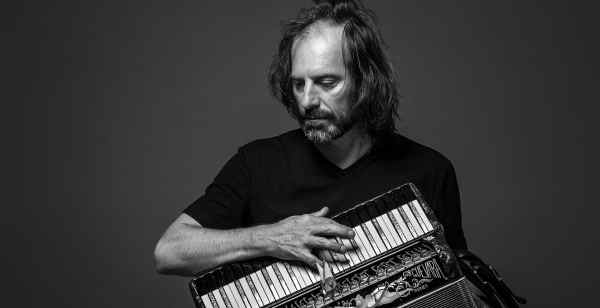

Chango Spasiuk
Quite distinct from Argentine tango, what resulted is the genre now known as chamamé. First described in the 19th-century accounts, chamamé is a lyrical 6/8 social dance form. But as with other genres whose development preceded recording technology, little is known about its evolution prior to the first chamamé 78–RPMs tracked in 1930s Buenos Aires by RCA. Over a career spanning 35 years, Chango Spasiuk has become a distinguished chamamé exponent, and a scholar of folk traditions from Argentina, Paraguay, Bolivia, Uruguay, and Brazil. and has toured all over the world. I first saw Chango perform at Nuremberg’s Bardentreffen Festival, and when the opportunity later arose, produced his ensemble in concert at Princeton’s Richardson Auditorium. Many years later, people who were present still recall being spellbound with the meditative spirit Chango and crew conjured that evening. This is a case where live performance has it all over any recorded artifact, but Eiké still captures the brilliant heart and soul of this project. Eiké is a Guaraní word signifying a social invitation into a soulful open space, reference to the recording’s origin during the enforced isolation of COVID. It also represents a newer experimental phase in Chango’s global artistic trajectory, incorporating contributions from fellow artists in Argentina (Gustavo Santaolalla, ronroco-charango; Sergio Tarnoski, accordion; Marcelo Dellamea, guitar), Brazil (Jaques Morelenbaum, cello), Paraguay (Sixto Corbalán, harp), Spain (Carlos Núñez, Galician flute), France (Erik Truffaz, trumpet), Norway (Einar Watle, guitar; Steinar Raknes, contrabass), Morocco (Majid Bekkas, oud), and Senegal (Boubacar Cissokho, kora).
In addition to nine originals (including an unexpected piano solo, “Improvisación para Juana”), Chango reinterprets three chamamé classics by Isaco Abitbol (“Siete Higueras,” seven daydreams), Luis Angel Monzón (“Puestero Lobizón,” the werewolf ranch hand of Guaraní mythology), and Heraclio Pérez (“Puerto Tirol,” a Chaco Province town founded in the 1880s by South Tyrolean immigrants). This is an opus beyond category.
Of his work, Chango remarks, "Chamamé is a prayer that dances. The accordion is a very physical instrument, and if you play with a lot of energy, the body soon starts to move without thinking. When the audience stops thinking and starts to feel, then they begin to understand what this music is about. I am not trying to be a virtuoso. What interests me is the music, and the ideas and feelings it carries. More than simple entertainment, it tends to a reflective, introspective space. Fundamentally I am a bit conservative when it comes to sustaining its formality, its sobriety, its spontaneity, and the connection it can evoke with the audience.” Possessed of an entranced and entrancing stage presence, Chango Spasiuk and his artistic partners summon an atmospheric music of profound serenity, beauty, and feeling. Articulating a dark melancholy, so much a part of Argentine history, his work sustains a tragic sense of hope and longing before the impermanence of all human endeavors.
Search RootsWorld
|